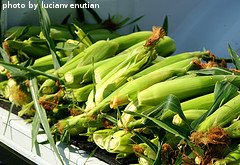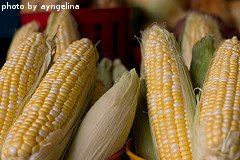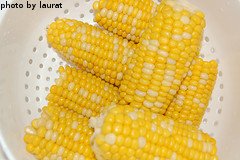How To Harvest Corn
Looking for information about how to harvest corn? You've come to the right place. The key to harvesting corn is timing. If you pick it too early, it won't reach maximum sweetness and might be too hard. If you wait too long, the kernels may be too tough and starchy.
If you grow sweet corn long enough, you'll get to the point where you can really fine-tune the timing of your harvest to get the maximum flavor and sugar content. In our own garden, we've got the timing down so that we oftentimes choose to wait just a few extra hours before picking our sweet corn to maximize its sweetness. Sometimes we'll go out and check it in the morning and find that it's just not quite ready. Then we'll go back in the afternoon or evening and find that the sweet corn is just right and ready to be picked. Believe it or not, those few extra hours can make a noticeable difference in the quality and sweetness of the corn.
How To Harvest Corn Step By Step

There are several ways to tell if it's time to harvest corn. In general, the ears are ready to be picked about 3 weeks after the silks first appear. You want the silks to be brown and dry. Typically, if the silks are still green at the top, the corn is still immature. If the silk looks ready, peel back the husk just enough to see the top few rows kernels on the ear. You want the kernels to be plump, almost like they are ready to burst open. Poke a kernel with your fingernail. A thin, white liquid will emerge if the corn is ready to be picked. If the liquid is clear, the ear is not ripe enough. If the liquid is thick, it may be slightly over-ripe.
You can also taste a raw kernel. It should be very sweet and fairly firm. We just use a pocket knife to cut off a couple of kernels to taste them. The kernels should fill out the ear, almost to the top. If the kernels don't reach the top of the ear, but all signs point to it being ripe and ready to eat, go ahead and harvest it anyway and cut off the top of the ear before serving.

If you determine that it's the right time for harvesting corn, hold the stalk with one hand. Use your other hand to grasp the ear and pull it down and away from the plant. It should release fairly easily. If needed, twist the ear slightly to get it to pop off the stalk. By holding the corn stalk, you will prevent the possibility of damaging the plant that might be holding other ears.
Unless you plan on eating them right away, store the ears of corn in a refrigerator, leaving the husks on. They will keep for almost a week. If you want to wait longer, clean the ears (removing the husks and silks) and blanch them in boiling water for 2 minutes. Then you can put them into an airtight bag and store them in the freezer until you're ready to use them.
Another option for freezing corn is to cut it off the cob first. There's a couple of different ways to do this. If you have an electric carving knife (like what you might use to carve a turkey or ham), it works great for cutting corn off the cob. We also like to use a corn cob stripper to remove the kernels from the cob. Once the kernels are removed, blanch them in boiling water for 2 minutes and then drain. Store the blanched corn in airtight bags in the freezer. We like to use quart-sized bags because that's about the right amount for a meal for our family. If you have a large family, you might want to freeze your corn in gallon-sized bags.
The other main way to preserve the sweet corn you grow is to can it. We like to use quart-sized jars and we raw pack the corn kernels in the jars. We then add boiling water to cover the corn and process it in a pressure canner.
After the growing season is over, remove the dead corn stalks from your garden. In general, unless you grind them up into very small pieces, corn stalks are usually a bit too tough to compost. We typically like to leave the stalks standing in the garden until they are dried out. Then we pull them out by the roots, put them in a pile and burn them.
So now you have a bumper crop of sweet corn. Ready for a few recipe ideas?

Click here for some great corn recipes
Click here to leave our How To Harvest Corn page and return to the Growing Sweet Corn main page
Click here to return to our Home page